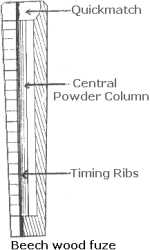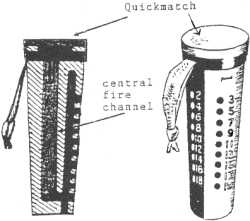|
Home History index
The Gun - Smoothbore Era 1550-1860: Fuzes
previous | index | next
About 1870 a fuze made of beech wood was introduced for common shell. Later a shorter version was adopted for shrapnel which in those days had an effective range of only 1100 yards (1006 metres), needing a shorter burning time.
 In the beech wood time fuze (shown right) the outer surface was ribbed, each rib indicating a burning time of half a second for the column of powder in the centre. To 'set' the fuze, the Gunner sawed off the lower end at the appropriate rib and discarded it. He then inserted the upper end in the shell and tightened it with a few blows from a mallet! Flash from the propellant charge via the quickmatch at the top initiated burning of the central column, which then exploded the burning charge. This crude arrangement was in use throughout the Napoleonic Wars until 1879 in Europe and 1858 in India. In the beech wood time fuze (shown right) the outer surface was ribbed, each rib indicating a burning time of half a second for the column of powder in the centre. To 'set' the fuze, the Gunner sawed off the lower end at the appropriate rib and discarded it. He then inserted the upper end in the shell and tightened it with a few blows from a mallet! Flash from the propellant charge via the quickmatch at the top initiated burning of the central column, which then exploded the burning charge. This crude arrangement was in use throughout the Napoleonic Wars until 1879 in Europe and 1858 in India.
 Boxer's improved fuze (shown left), introduced in 1849, was of wood, usually beech. To 'set' it the Gunner bored a hole with a gimlet at the appropriate setting then hammered it into the shell with a mallet as with the earlier type. Flash from the propellant charge ignited the quickmatch at the top of the fuze, which in turn ignited the central filling, which burned down to the hole previously bored. The flash then went through the hole to ignite bursting charge or main filling. Boxer's improved fuze (shown left), introduced in 1849, was of wood, usually beech. To 'set' it the Gunner bored a hole with a gimlet at the appropriate setting then hammered it into the shell with a mallet as with the earlier type. Flash from the propellant charge ignited the quickmatch at the top of the fuze, which in turn ignited the central filling, which burned down to the hole previously bored. The flash then went through the hole to ignite bursting charge or main filling.
WL Ruffell, 1997
Return to top
previous | index | next |
History index | Home
|
 In the beech wood time fuze (shown right) the outer surface was ribbed, each rib indicating a burning time of half a second for the column of powder in the centre. To 'set' the fuze, the Gunner sawed off the lower end at the appropriate rib and discarded it. He then inserted the upper end in the shell and tightened it with a few blows from a mallet! Flash from the propellant charge via the quickmatch at the top initiated burning of the central column, which then exploded the burning charge. This crude arrangement was in use throughout the Napoleonic Wars until 1879 in Europe and 1858 in India.
In the beech wood time fuze (shown right) the outer surface was ribbed, each rib indicating a burning time of half a second for the column of powder in the centre. To 'set' the fuze, the Gunner sawed off the lower end at the appropriate rib and discarded it. He then inserted the upper end in the shell and tightened it with a few blows from a mallet! Flash from the propellant charge via the quickmatch at the top initiated burning of the central column, which then exploded the burning charge. This crude arrangement was in use throughout the Napoleonic Wars until 1879 in Europe and 1858 in India.
 Boxer's improved fuze (shown left), introduced in 1849, was of wood, usually beech. To 'set' it the Gunner bored a hole with a gimlet at the appropriate setting then hammered it into the shell with a mallet as with the earlier type. Flash from the propellant charge ignited the quickmatch at the top of the fuze, which in turn ignited the central filling, which burned down to the hole previously bored. The flash then went through the hole to ignite bursting charge or main filling.
Boxer's improved fuze (shown left), introduced in 1849, was of wood, usually beech. To 'set' it the Gunner bored a hole with a gimlet at the appropriate setting then hammered it into the shell with a mallet as with the earlier type. Flash from the propellant charge ignited the quickmatch at the top of the fuze, which in turn ignited the central filling, which burned down to the hole previously bored. The flash then went through the hole to ignite bursting charge or main filling.